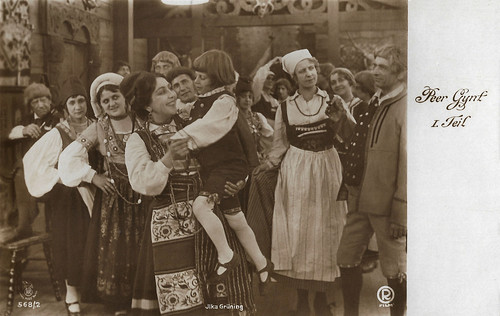
German postcard in the Film-Sterne series by Rotophot, no. 568/2. Photo: Richard Oswald-Film. Ilka Grüning as Aase in Peer Gynt (Victor Barnowsky, 1919).
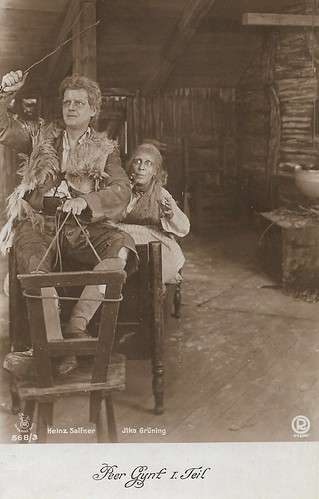
German postcard in the Film Sterne series by Rotophot, no. 568/3. Photo: Richard Oswald-Film. Heinz Salfner as Peer Gynt and Ilka Grüning as his mother Aase in Peer Gynt (Victor Barnowsky, 1919).
Part I: Peer's Youth
Norway in the 19th century: Peer Gynt (Heinz Salfner) is a powerful peasant boy who tries to steal himself out of his miserable reality with made-up stories. He suppresses the fact that his father Jon Gynt (Hans Sternberg), once a respected man in the village and the surrounding area, is in danger of losing his farm and possessions through mismanagement and alcoholic excesses.
In Peer's imagination, the run-down house is still a magnificent palace. Peer also manages to suppress the fact that he himself is a good-for-nothing. He sees himself as a hero and knows how to make his mother Aase (Ilka Grüning) believe what a 'hotshot' he is.
Aase, for whom the day thief and dreamer Peer means everything to her, transfigures the young man in her imagination, who not only lets the farm degenerate more and more and imagines himself in a world of trolls and demons, but also walks with much enthusiasm but ultimately only little success on suitor's feet.
The button caster (Conrad Veidt), a figure from the dreams of his childhood, seduces Gynt into a series of foolish deeds. One day Peer kidnaps Ingrid (Irmgard von Hansen), someone else's bride, while at the same time he meets the decent and demure Solveig (Lina Lossen). Solveig is the exact opposite of Gynt: down-to-earth and faithful. She would be the one to finally set him on the path of virtue. But the restless spirit Peer is drawn to faraway places.

German postcard in the Film Sterne series by Rotophot, no. 569/1. Photo: Richard Oswald-Film. Heinz Salfner as Peer Gynt and Lina Lossen as Solveig in Peer Gynt (Victor Barnowsky, 1919).
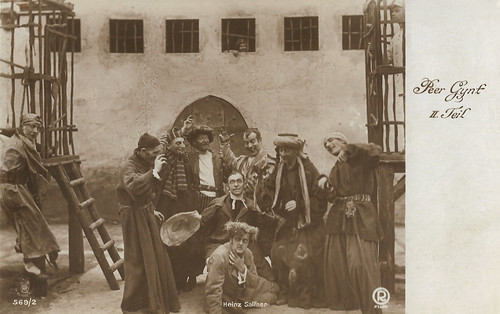
German postcard in the Film Sterne series by Rotophot, no. 569/2. Photo: Richard Oswald-Film. Heinz Salfner as Peer Gynt in Peer Gynt 2. Teil (Victor Barnowsky, 1919).
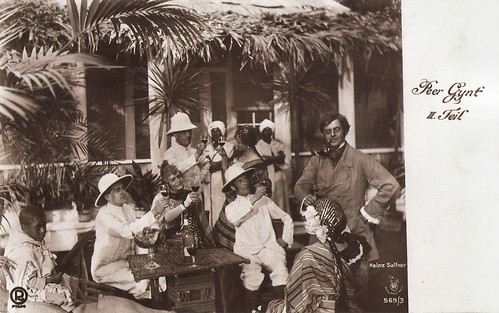
German postcard in the Film Sterne series by Rotophot, no. 569/3. Photo: Richard Oswald-Film. Heinz Salfner as Peer Gynt in Peer Gynt 2. Teil (Victor Barnowsky, 1919).
Part II: Peer's Wanderings and Death
Peer believes that he must now set out into the 'wide world' in search of adventure and prosperity. And so he leaves, leaving behind the kind-hearted Solveig. Gynt subsequently experiences the longed-for adventures.
Three decades later, Peer Gynt has become rich in Africa, among other things through slave trading, and has finally settled in Morocco. There, however, his business partners steal his ship and all his valuable possessions. His ship sinks and Peer seems to have come to terms with his renewed poverty.
In these moments, he finds God and begins to understand what the true values of life are. One day, he is driven by certain circumstances to the Sahara Desert, where he finds salvation in an oasis. Here he meets Anitra (Anita Berber or Hanna Lierke), as mysterious as she is soulless, who first steals his heart and eventually his remaining possessions.
But he has still not reached the lowest point of his life: in Cairo, Peer Gynt ends up in an insane asylum run by the German doctor Dr. Begriffenfeldt (Georg John). But finally, for once, he is lucky. Here he meets compatriots, sailors who have gone ashore locally, who are willing to take the now purified Peer Gynt back to his old home.
Old and impoverished, Peer Gynt returns home, where Solveig has been waiting for him as promised. And the faithful soul has not remained idle all these years: she has managed the dilapidated farm and brought it back to shape. She not only makes sure that Gynt finds a home, but also his salvation with her. Now he can die at peace with himself and his life.
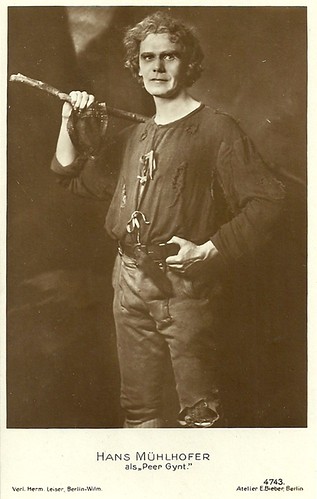
German postcard by Verlag Hermann Leiser, no. 4743. Photo: Atelier Bieber, Berlin. Hans Mühlhofer in one of the many German stage versions of Peer Gynt.

German postcard by Verlag Hermann Leiser, Berlin, no. 7834. Photo: Becker & Maass. Friedrich Kayssler as Peer Gynt and Ilka Grüning as his mother Aase in Ibsen's play 'Peer Gynt'. Kayssler debuted as Peer Gynt in the eponymous play by Ibsen at the Lessingtheater in Berlin, on 15 September 1913. Ilka Grüning already then played his mother Aase. With the Lessing Theater company, Kayssler and Grüning would perform the play in Spring 1914 at the Neues Deutsches Theater in Prague, the Theater an der Wien in Vienna, and the Lobe-Theater at Breslau/Wroclaw.

German postcard by Verlag Herm. Leiser, Berlin Wilm., no. 5192. Photo: Becker & Maass, Berlin. Theodor Loos in the play 'Peer Gynt' by Henrik Ibsen.

German postcard by Verlag Hermann Leiser, Berlin, no. 8331. Photo: Becker & Maass. Carl Clewing in 'Peer Gynt'. On stage, Clewing was popular in his performance of Ibsen's Peer Gynt, which he staged in 1914, 1915, 1916 and 1919, all at the Königliches Schauspielhaus in Berlin (from 1919: Staatstheater).

German postcard by Verlag Herm. Leiser, Berlin-Wilm., no. 8334. Photo: Becker & Maass. Caption: Helene Thimig as Solveig in 'Peer Gynt'. Thimig appeared in the play by Henrik Ibsen in 1914-1915.

German postcard, 1931-1932. Photo: Arnecke, Cologne. Rudolf Wittgen in 'Peer Gynt' (1931-1932). Wittgen debuted in 'Peer Gynt' in Cologne at the Schauspielhaus on 21 November 1931. The photo on this card must have been made then. Three years before (1928) Wittgen had already played Peer Gynt in Stuttgart at the Württembergisches Landestheater. As far as known, Witten didn't act in cinema.

German collectors card in the series 'Vom Werden deutscher Filmkunst - Der Tonfilm', album no. 11, picture no. 175. Photo: Bavaria-Tofa / Ross Verlag. Marieluise Claudius and Hans Albers in Peer Gynt (Fritz Wendhausen, 1934).
Source: Wikipedia (German and English) and IMDb.
No comments:
Post a Comment